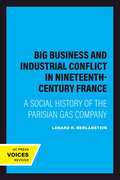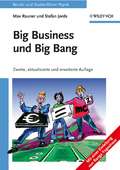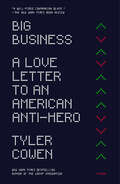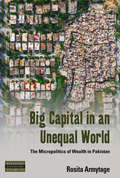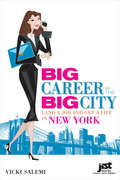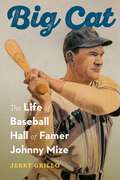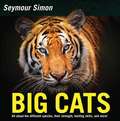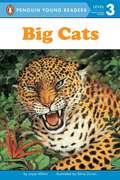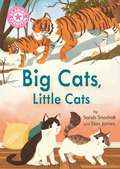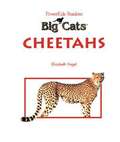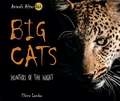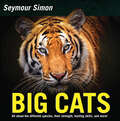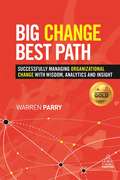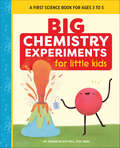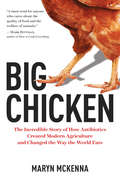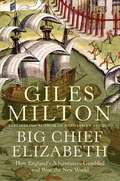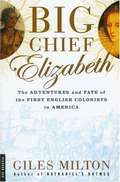- Table View
- List View
Big Business and Industrial Conflict in Nineteenth-Century France: A Social History of the Parisian Gas Company
by Lenard R. BerlansteinFounded in 1855, the Parisian Gas Company (PGC) quickly developed into one of France's greatest industrial enterprises, an exemplar of the new industrial capitalism that was beginning to transform the French economy. The PGC supplied at least half the coal gas consumed in France through the 1870s and became the city's single largest employer of clerical and factory labor. Representing a new form and scale of capitalistic endeavor, the firm's history illuminates the social tensions that accompanied the nation's industrialization and democratization.To study the company over its fifty-year life is to see industrializing France writ small. Using previously untapped company archives, Lenard R. Berlanstein has written a rich and detailed study that skillfully bridges the divide between business, social, and labor history.
Big Business and Presidential Power: From FDR to Reagan
by Kim McquaidTHIS IS A BOOK about patterns of interaction between big businessmen and the federal government during the past half century. It was written on the assumption that the primary responsibility of the historian is to tell a good story about what happened and why it happened, in as brief a fashion as possible. The work, therefore, is comparatively free of technical jargon. As information regarding high-level interaction between corporate and governmental leaders is often extremely hard to come by, notes have been included to direct particularly interested readers to the relevant source materials.
Big Business und Big Bang: Berufs- und Studienführer Physik
by Max Rauner Stefan JordaSie wollen studieren, aber was? Physik hat schlechte Karten - ein langes, schwieriges Studium, schlechte Berufsaussichten und geringes Gehalt, denken Sie. Mit der Realität auf dem Arbeitsmarkt haben diese Vorurteile wenig zu tun: Dass Physiker nicht ständig im Labor stehen oder gerade eine geniale Idee ausbrüten, hat sich kaum herumgesprochen. Dabei arbeiten sie nach dem Studium in Banken und Versicherungen, als Forschungsmanager und Patentanwalt, in der Automobilbranche und Telekommunikation, bei Optikfirmen und Unternehmensberatungen. Von Big Business bis Big Bang gibt es kaum ein Gebiet, auf dem sie nicht vertreten sind. Diese zweite, ergänzte Auflage beinhaltet zusätzlich Medizinphysik, Chemie und die Energiebranche als Berufsportraits; darüber hinaus aktuelle Informationen über Bachelor-Master-Studiengänge sowie einen aktualisierten Serviceteil.
Big Business: A Love Letter to an American Anti-Hero
by Tyler CowenAn against-the-grain polemic on American capitalism from New York Times bestselling author Tyler Cowen.We love to hate the 800-pound gorilla. Walmart and Amazon destroy communities and small businesses. Facebook turns us into addicts while putting our personal data at risk. From skeptical politicians like Bernie Sanders who, at a 2016 presidential campaign rally said, “If a bank is too big to fail, it is too big to exist,” to millennials, only 42 percent of whom support capitalism, belief in big business is at an all-time low. But are big companies inherently evil? If business is so bad, why does it remain so integral to the basic functioning of America? Economist and bestselling author Tyler Cowen says our biggest problem is that we don’t love business enough. In Big Business, Cowen puts forth an impassioned defense of corporations and their essential role in a balanced, productive, and progressive society. He dismantles common misconceptions and untangles conflicting intuitions. According to a 2016 Gallup survey, only 12 percent of Americans trust big business “quite a lot,” and only 6 percent trust it “a great deal.” Yet Americans as a group are remarkably willing to trust businesses, whether in the form of buying a new phone on the day of its release or simply showing up to work in the expectation they will be paid. Cowen illuminates the crucial role businesses play in spurring innovation, rewarding talent and hard work, and creating the bounty on which we’ve all come to depend.
Big Capital in an Unequal World: The Micropolitics of Wealth in Pakistan (Dislocations #29)
by Rosita ArmytageFollowing the hidden lives of the global “1%”, this book examines the networks, social practices, marriages, and machinations of the elite in Pakistan. In doing so, it reveals the daily, even mundane, ways in which elites contribute to and shape the inequality that characterizes the modern world. Operating in a rapidly developing economic environment, the experience of Pakistan’s wealthiest and most powerful members contradicts widely held assumptions that economic growth is leading to increasingly impersonalized and globally standardized economic and political structures.
Big Career in the Big City
by Vicki SalemiThis one-of-a-kind guide deals with the logistics of moving to a new city; reveals how to cope with unfamiliar and sometimes stressful living arrangements; and offers suggestions on how to stick to a budget and stretch the almighty dollar.
Big Cars (Cars, Cars, Cars Ser.)
by Melissa AbramovitzRoom for nine people? Space for a swimming pool? Make way for some seriously big cars!
Big Cat: The Life of Baseball Hall of Famer Johnny Mize
by Jerry GrilloJohnny Mize was one of the greatest hitters in baseball&’s golden age of great hitters. Born and raised in tiny Demorest, Georgia, in the northeast Georgia mountains, Mize emerged from the heart of Dixie as a Bunyonesque slugger, a quiet but sharp-witted man from a broken home who became a professional player at seventeen, embarking on an extended tour of the expansive St. Louis Cardinals Minor League system. Mize then spent fifteen seasons terrorizing Major League pitchers as a member of those Cardinals, the New York Giants of Mel Ott and Leo Durocher, and finally with the New York Yankees, who won a record five straight World Series with Mize as their ace in the hole—the best pinch hitter in the American League. Few hitters have combined such meticulous bat control with brute power the way Mize did. Mize was a line-drive hitter who rarely struck out and also hit for distance, to all fields, and usually for a high average. Nicknamed the Big Cat, &“nobody had a better, smoother, easier swing than John,&” said Cardinals teammate Don Gutteridge. &“It was picture perfect.&” Tabbed as a can&’t-miss Hall of Famer, then all but forgotten, Mize spent twenty-eight years waiting for the call from Cooperstown before he was finally inducted in 1981, delighting fans with his straightforward commentary and sly sense of humor during a memorable induction speech. From the backroads of the Minor Leagues to the sunny Caribbean, where he played alongside the best Black and Latin players as a twenty-one-year-old, and to the Major Leagues, where he became a ten-time All-Star, home run champion, and World Series hero, Mize forged a memorable trail along baseball&’s landscape. This is the first complete biography of the Big Cat.
Big Cats
by Seymour SimonIn this completely updated edition of Big Cats, award-winning writer Seymour Simon celebrates the grace and power of lions, tigers, leopards, jaguars, cheetahs, pumas, and snow leopards. Readers will learn all about how they hunt, care for their young, and rest in their varied natural habitats.
Big Cats (Penguin Young Readers, Level 3)
by Joyce MiltonLevel Three From tigers to cougars and leopards to lions, this book is a great introduction to big cats. Topics discussed include hunting techniques, sleeping habits, color patterns, and the importance of preserving the cats' habitats.
Big Cats, Little Cats: Independent Reading Pink 1B Non-fiction (Reading Champion #515)
by Sarah SnashallDiscover the similarities and differences between large, wild cats and small, domestic cats with this non-ficiton reader.This book is part of Reading Champion, a series carefully linked to book bands to encourage independent reading skills, developed with Dr Sue Bodman and Glen Franklin of UCL Institute of Education (IOE)Reading Champion offers independent reading books for children to practise and reinforce their developing reading skills.Fantastic, original stories are accompanied by engaging artwork and a reading activity. Each book has been carefully graded so that it can be matched to a child's reading ability, encouraging reading for pleasure.Perfect for children aged 4-5 or reading at book band Pink 1B.
Big Cats: Cougars
by Victor Gentle Janet PerryAn introduction to the physical characteristics, behaviour, and natural environment of the cougar or puma, a wild cat of the Americas that continues to decline in number.
Big Cats: Hunters Of The Night (Animals After Dark)
by Elaine LandauLions, tigers, leopards, and jaguars are all big cats, and you would not like to meet them in the dark! They rest during the day but come to life at night to hunt. With a mighty roar, the big cats chase down their prey. Sharp teeth and claws and powerful jaws mean certain doom. Author Elaine Landau tells the reader all about these beautiful hunters: how they hunt, where they live, and what the future holds for the big cats.
Big Cats: Leopards
by Victor Gentle Janet PerryAn introduction to the physical characteristics and behaviour of the leopard, a smart predator that can climb trees and that lives in a variety of environments.
Big Cats: Lions
by Victor Gentle Janet PerryDescribes how male and female lions live, especially their hunting, mating, and territorial behaviour
Big Cats: Lynxes
by Victor Gentle Janet PerryDescribes the physical characteristics, behaviour, and habitat of lynxes.
Big Cats: Revised Edition
by Seymour SimonIn this completely updated edition of Big Cats, award-winning writer Seymour Simon celebrates the grace and power of lions, tigers, leopards, jaguars, cheetahs, pumas, and snow leopards. Readers will learn all about how they hunt, care for their young, and rest in their varied natural habitats. This nonfiction picture book is packed with information and beautiful color photographs. Cat fans and kids ages 6 to 10 looking for facts, whether for a report or just for fun, will find much to like in Big Cats.This updated edition includes:Author’s noteStunning full-color photographsGlossaryIndexAdditional reading sourcesSupports the Common Core Learning Standards, Next Generation Science Standards, and the Science, Technology, Engineering, and Math (STEM) standards.
Big Change, Best Path
by Warren ParryUsing ground-breaking modelling, Big Change, Best Path brings unique insights to the dynamics and process of organizational change, understanding success and failure, defining and describing the drivers and conditions of change, and the patterns and paths of organizational change. Author Warren Parry from Accenture Strategy shows that a whole new way of managing change is possible, from empirical benchmarking, predictive approaches that highlight the specific actions needed at any point of a change program, and visualization for senior managers to show how each part of an organization is responding. The author also challenges many of the myths of change management and the dynamics of how organizations respond to change, clearly showing the common pitfalls and misunderstandings. Big Change, Best Path explains a new, more analytical way and process for driving successful change, and presents a ground-breaking vision for the future of how organizations can become more agile and resilient.
Big Chemistry Experiments for Little Kids: A First Science Book for Ages 3 to 5 (Big Experiments for Little Kids)
by Megan Olivia HallLearn science through play with interactive chemistry experiments for kids ages 3 to 5Little kids love to ask questions about the world around them, and the best way for them to find answers is with their own two hands! This exciting book about science for preschool and kindergarten kids features 20 quick and easy chemistry projects that your little learner will want to try again and again.Science for kids—Kids can create slippery slime, draw a picture with invisible ink, and make a rain cloud in a cup, all with easy-to-find household materials.Simple steps—These experiments are easy enough for young children to do with just a little help, and most only take about 20 minutes.Explore chemistry—Each experiment illustrates a chemical reaction—from bubbling seashells to an exploding volcano—and enhances learning with questions and explanations about each project.Encourage kids to explore why things work with a fun and simple book of science for kids.
Big Chicken: The Incredible Story of How Antibiotics Created Modern Agriculture and Changed the Way the World Eats
by Maryn MckennaIn this eye-opening exposé, acclaimed health journalist and National Geographic contributor Maryn McKenna documents how antibiotics transformed chicken from local delicacy to industrial commodity—and human health threat—uncovering the ways we can make America's favorite meat safer again. What you eat matters—for your health, for the environment, and for future generations. In this riveting investigative narrative, McKenna dives deep into the world of modern agriculture by way of chicken: from the farm where it's raised directly to your dinner table. Consumed more than any other meat in the United States, chicken is emblematic of today's mass food-processing practices and their profound influence on our lives and health. Tracing its meteoric rise from scarce treat to ubiquitous global commodity, McKenna reveals the astounding role of antibiotics in industrial farming, documenting how and why "wonder drugs" revolutionized the way the world eats—and not necessarily for the better. Rich with scientific, historical, and cultural insights, this spellbinding cautionary tale shines a light on one of America's favorite foods—and shows us the way to safer, healthier eating for ourselves and our children.
Big Chicken: The Incredible Story of How Antibiotics Created Modern Agriculture and Changed the Way the World Eats
by Maryn MckennaIn this eye-opening exposé, acclaimed health journalist and National Geographic contributor Maryn McKenna documents how antibiotics transformed chicken from local delicacy to industrial commodity—and human health threat—uncovering the ways we can make America's favorite meat safer again. What you eat matters—for your health, for the environment, and for future generations. In this riveting investigative narrative, McKenna dives deep into the world of modern agriculture by way of chicken: from the farm where it's raised directly to your dinner table. Consumed more than any other meat in the United States, chicken is emblematic of today's mass food-processing practices and their profound influence on our lives and health. Tracing its meteoric rise from scarce treat to ubiquitous global commodity, McKenna reveals the astounding role of antibiotics in industrial farming, documenting how and why "wonder drugs" revolutionized the way the world eats—and not necessarily for the better. Rich with scientific, historical, and cultural insights, this spellbinding cautionary tale shines a light on one of America's favorite foods—and shows us the way to safer, healthier eating for ourselves and our children.
Big Chief Elizabeth: How England's Adventurers Gambled and Won the New World
by Giles MiltonIn April 1586, Queen Elizabeth I acquired a new and exotic title. A tribe of North American Indians had made her their weroanza - 'big chief'.The news was received with great joy, both by the Queen and her favourite, Sir Walter Ralegh. His first American expedition had brought back a captive, Manteo, whose tattooed face had enthralled Elizabethan London. Now Manteo was returned to his homeland as Lord and Governor. Ralegh's gamble would result in the first English settlement in the New World, but it would also lead to a riddle whose solution lay hidden in the forests of Virginia.A tale of heroism and mystery, Big Chief Elizabeth is illuminated by first-hand accounts to reveal a remarkable and long-forgotten story.
Big Chief Elizabeth: How England's Adventurers Gambled and Won the New World
by Giles MiltonIn April 1586, Queen Elizabeth I acquired a new and exotic title. A tribe of North American Indians had made her their weroanza - 'big chief'.The news was received with great joy, both by the Queen and her favourite, Sir Walter Ralegh. His first American expedition had brought back a captive, Manteo, whose tattooed face had enthralled Elizabethan London. Now Manteo was returned to his homeland as Lord and Governor. Ralegh's gamble would result in the first English settlement in the New World, but it would also lead to a riddle whose solution lay hidden in the forests of Virginia.A tale of heroism and mystery, Big Chief Elizabeth is illuminated by first-hand accounts to reveal a remarkable and long-forgotten story.
Big Chief Elizabeth: The Adventures and Fate of the First English Colonists in America
by Giles MiltonLondon-based writer Milton (Nathaniel's Nutmeg) traces attempts by English adventurers to claim, divide, and colonize North America, from Richard Hore's 1536 journey through Walter Raleigh's extravagant expeditions to Roanoke Island and Jamestown, which led to the first permanent English settlements in the New World. Annotation c. Book News, Inc., Portland, OR (booknews.com)
